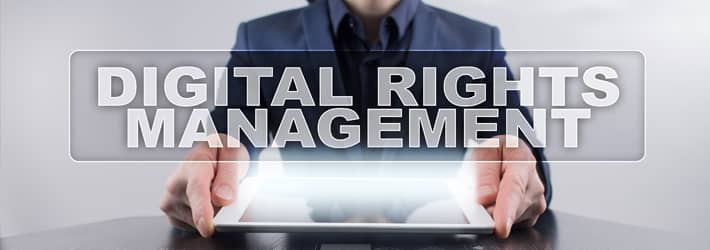Last Updated on January 17, 2025 by Deepanshu Sharma

Digital media assets such as documents, images, videos, software are valuable content whose loss or unauthorized use could cause significant loss to the owners and copyright holders.
Therefore, they require protection from people who may want to exploit them for their gain. This is often a challenge due to the digital nature of storage and delivery of these assets.
This is where digital rights management or DRM comes in.
Digital Rights Management is the technology that controls access to content on digital devices. It helps protect the rights of the copyright holder or owner of digital assets and even the users of the assets. This technology defines how end-users interact with the digital assets.
With the continued digitization of all spheres of our life, including work and entertainment, Digital Rights Management has become a critical part of businesses and individuals who want to protect their digital assets and ensure only legitimate and licensed users access them.
How Digital Rights Management Works
Digital Rights Management platform deploys code that controls how end-users can use the digital files. Typically, it can be used to prevent sharing, modification, copying, storing, or limiting the devices that can access it. Digital Rights Management technology can either be hardware or software, with both options effective in introducing access control and permission management.
To achieve access control, the Digital Rights Management platform can:
- Deploy watermarks on documents and images to show ownership
- Capturing and monitoring copyright and license information through metadata
- Require encryption and decryption keys to access data
- Set expiry dates on digital assets, thus preventing unlimited access.
- Restrict users from copying, editing, printing, sharing, or storing the media on their devices. It can also restrict taking screengrabs or screenshots of the content.
- Restrict access to specific devices, IP addresses, or users in particular locations
- Use of embed codes to control how digital assets are published online
Digital Rights Management Use Cases
We can broadly categorize Digital Rights Management use cases into four distinct areas based on what we currently see in the IT landscape.
Entertainment/ media industry
Content creators and media companies in the entertainment industry spend a lot of resources to develop digital content with the hope of earning from it. Pirated copies of their works have always been a thorn in the flesh. Digital Rights Management software gives them more control of the work and safeguards their income.
Tech industry
Like in the entertainment industry, tech companies have borne the pain of pirated copies of their software. In addition to offering software as a service, most software companies have also deployed Digital Rights Management tools to entrench their ownership rights and income.
Enterprises
Enterprise digital rights management helps organizations, companies, and government departments protect their confidential data, share files, comply with relevant laws, collaborate with other organizations, among many other uses.
Benefits of Digital Rights Management Technology
There are many benefits that businesses/organizations derive from Digital Rights Management. It is not possible to discuss all of them in this article, but let’s look at the most critical:
Protecting confidential data
Confidential data such as proprietary information, customer data, strategic plans, employee data, health records, etc., can bring down an organization if the wrong people get hold of it. Digital Rights Management helps protect this data by tracking and restricting access.
Prevent unauthorized use
When users purchase a license to digital assets, they usually agree to abide by specific fair use policies. Digital Rights Management enforces these policies by applying the restrictions.
Protecting revenues by monetizing content effectively
By preventing unscrupulous people from copying other people’s work, individuals and businesses owing digital media assets stand a chance to get a return on their investment.
Compliance with relevant laws
Different regions have laws that govern how specific data and content should be distributed. Some sensitive government files may only be accessed in specified locations.
Other regulations like HIPPA protect confidential healthcare records. Digital Rights Management software comes in handy in ensuring data security.
Digital Rights Management helps restrict content to the right audiences to comply with relevant regulations. Age restriction and regional restriction are easily achieved with Digital Rights Management software.
Enterprise file security
File sharing is a common feature of the modern workplace. With it comes the challenges of data loss. Digital Rights Management software help mitigates this threat by controlling access. It can go further and help investigators understand how data leakage occurred.
Criticisms of Digital Rights Management Platforms
With all the benefits Digital Rights Management offers to digital assets owners, it isn’t devoid of criticism. Perhaps the biggest one is whether it limits legitimate users who have purchased rights to an asset from using it optimally. Some Digital Rights Management platforms lean heavily on protecting owner’s rights and hurt the end-user in the process.
Since Digital Rights Management technologies define and control how users can interact with the content, the question of legitimate license holders facing difficulties consuming the content they paid for arises.
Digital Rights Management software can sometimes hinder the smooth flow of work by introducing stringent restrictions even on less sensitive files in the workplace. CISOs should be open to feedback from users on how Digital Rights Management software may be affecting their work.
A robust Digital Rights Management platform balances the rights of content owners with the legitimate expectations of users who have obtained a license to such content. The user experience should be seamless and unobtrusive to the greatest extent possible.
Closing Thoughts
With the number of digital assets being produced daily across different sectors, digital rights management platforms are very important.
It’s one way to protect your organization from the cybersecurity challenges posed by threat actors out to profit from your digital assets.
In addition, this technology will help protect your customer data and help with compliance by ensuring your content is distributed legally and complies by all data privacy laws.
If you’d like to see how the Lepide Data Security Platform can help you detect and react to security threats within your infrastructure, schedule a demo with one of our engineers.


 Group Policy Examples and Settings for Effective Administration
Group Policy Examples and Settings for Effective Administration 15 Most Common Types of Cyber Attack and How to Prevent Them
15 Most Common Types of Cyber Attack and How to Prevent Them Why AD Account Keeps Getting Locked Out Frequently and How to Resolve It
Why AD Account Keeps Getting Locked Out Frequently and How to Resolve It
